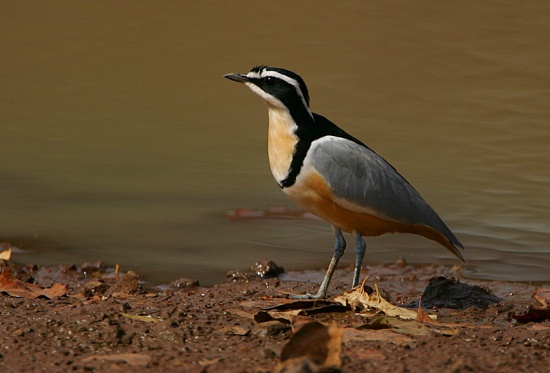- Pluvianus aegyptius
Identification
Egyptian Plover is a striking and unmistakable species. The 19-21 cm long adult has a black crown, back, eye-mask and breast band. The rest of the head is white. The remaining upperpart plumage is blue-grey, and the underparts are orange. The longish legs are blue-grey.
In flight, it is even more spectacular, with the black crown and back contrasting with the grey of the upperparts and wings. The flight feathers are brilliant white crossed by a black bar. From below, the flying bird is entirely white, apart from the orange belly and black wing bar. After landing, members of a pair greet each other by raising their wings in an elaborate ceremony that shows off the black and white markings. The sexes are similar, but juveniles are duller and the black marking are intermixed with brown
Distribution
Widespread but very patchy distribution in sub-Saharan Africa but current status in the Western Palearctic is unclear.
Formerly bred on the Nile in southern Egypt but now apparently a very rare vagrant. Also recorded as a vagrant to Libya (August 1969), and old and more doubtful records for Jordan and the Canary Islands. Further south in Africa moves erratically in response to changing water levels and presumably did so in Egypt.
These irregular movements may well lead to further Western Palearctic records but one in Poland in October-November 1991, another in Gironde, France from July 1999 to February 2000 and a third in Belgium in June 2000 were regarded as escapes.
Taxonomy
The Egyptian Plover, Pluvianus aegyptius, is a wader, the only member of the genus Pluvianus (Vieillot, 1816). Formerly placed in its own monotypic family Pluvianidae, it is now regarded as the sole member of the subfamily Pluvianinae, part of the pratincole and courser family, Glareolidae.
Habitat
Sandbanks, spits and islets along rivers and lakeshores, rarely in areas of brackish water. Sometimes in grassland and cultivated land close to freshwater. In main range often close to human habitation.
Behaviour
It is also sometimes referred to as the Crocodile Bird because it is famous for a symbiotic relationship with crocodiles. According to a story dating to Herodotus, the crocodiles lie on the shore with their mouths open, and the plovers fly into the crocodiles' mouths so as to feed on bits of decaying meat that are lodged between the crocodiles' teeth. The crocodiles do not eat the plovers, as the plovers are providing the crocodiles with greatly-needed dentistry. Two eminent ornithologists have supported this story anecdotally, but the behavior has never been authenticated (Richford and Mead 2003).
Egyptian Plover is a localised resident in tropical sub-Saharan Africa. It breeds on sandbars in large rivers. Its two or three eggs are not incubated, but are buried in warm sand, temperature control being achieved by the adult sitting on the eggs with a water-soaked belly to cool them. If the adult leaves the nest, it smooths sand over the eggs, though if it is frightened the job may be hasty. The chicks are precocial, and can run as soon as they are hatched and feed themselves shortly afterward. Adults' behaviors in regard to them resemble their behaviors with eggs: they cool the chicks in the same way, and the chicks may drink water from their belly feathers. Also, the adults bury the chicks in the sand temporarily if danger threatens.
This usually very tame bird is found in pairs or small groups near water. It feeds by pecking for insects, and by extracting fragments of meat from between crocodile teeth. The call is a high-pitched krrr-krrr-krrr.




